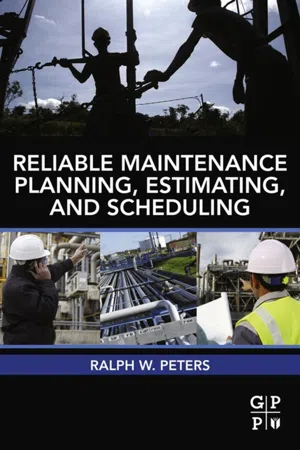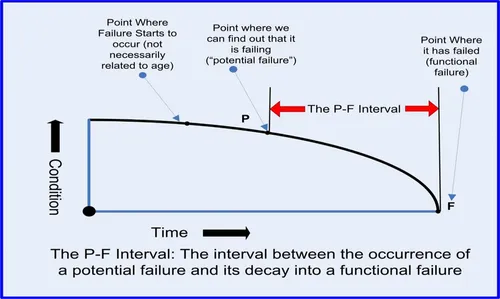
- 520 pages
- English
- ePUB (mobile friendly)
- Available on iOS & Android
Reliable Maintenance Planning, Estimating, and Scheduling
About this book
Written specifically for the oil and gas industry, Reliable Maintenance Planning, Estimating, and Scheduling provides maintenance managers and engineers with the tools and techniques to create a manageable maintenance program that will save money and prevent costly facility shutdowns. The ABCs of work identification, planning, prioritization, scheduling, and execution are explained. The objective is to provide the capacity to identify, select and apply maintenance interventions that assure an effective maintenance management, while maximizing equipment performance, value creation and opportune and effective decision making. The book provides a pre- and post- self-assessment that will allow for measure competency improvement. Maintenance Managers and Engineers receive an expert guide for developing detailed actions including repairs, alterations, and preventative maintenance.- The nuts and bolts of the planning, estimating, and scheduling process for oil and gas facilities- Step-by-step maintenance guide will provide long-term, results-based operational services- Case studies based on the oil and gas industry
Frequently asked questions
- Essential is ideal for learners and professionals who enjoy exploring a wide range of subjects. Access the Essential Library with 800,000+ trusted titles and best-sellers across business, personal growth, and the humanities. Includes unlimited reading time and Standard Read Aloud voice.
- Complete: Perfect for advanced learners and researchers needing full, unrestricted access. Unlock 1.4M+ books across hundreds of subjects, including academic and specialized titles. The Complete Plan also includes advanced features like Premium Read Aloud and Research Assistant.
Please note we cannot support devices running on iOS 13 and Android 7 or earlier. Learn more about using the app.
Information
Profit and Customer-Centered Benefits of Planning and Scheduling
Abstract
Keywords
Chief maintenance officer, CMO; Contract maintenance; Cost center; Customer-centered; Maintenance; Maintenance leader; Maintenance manager; P–F interval; Physical asset management; Planner/scheduler; Profit ability; Profit optimization; Profit-centered; Value-adding investments
Table of contents
- Cover image
- Title page
- Table of Contents
- Copyright
- About the Author
- Introduction
- 1. Profit and Customer-Centered Benefits of Planning and Scheduling
- 2. Defining Results to Top Leaders and Operations Leaders
- 3. Leadership: Creating Maintenance Leaders, Not Just Maintenance Managers
- 4. How to Create PRIDE in Maintenance within Craft Leaders and the Technical Workforce
- 5. Define Your Physical Asset Management Strategy with The Scoreboard for Maintenance Excellence and Go Beyond ISO 55000
- 6. Planners Must Understand Productivity and How Reliable Maintenance Planning, Estimating and Scheduling (RMPES) Enhances Total Operations Excellence
- 7. What to Look for When Hiring a Reliable Planner/Scheduler
- 8. Planner Review of the Maintenance Business System—Your CMMS-EAM System
- 9. Defining Maintenance Strategies for Critical Equipment With Reliability-Centered Maintenance (RCM)
- 10. Defining Total Maintenance Requirements and Backlog
- 11. Overview of a Reliable Planning-Estimating-Scheduling-Monitoring-Controlling Process
- 12. Why the Work Order Is a Prime Source for Reliability Information
- 13. Detailed Planning with a Reliable Scope of Work and a Complete Job Package
- 14. Understanding Risk-Based Maintenance by Using Risked-Based Planning with Risk-Based Inspections
- 15. Developing Improved Repair Methods and Reliable Maintenance Planning Times with the ACE Team Process
- 16. Successful Scheduling by Keeping the Promise and Completing the Schedule
- 17. Maintenance, Repair, and Operations (MRO) Material Management: The Missing Link in Reliability
- 18. How to Measure Total Operations Success with the Reliable Maintenance Excellence Index
- 19. How This Book Can Apply to the Very Small Work Unit in Oil and Gas or to Any Type of Maintenance Operation
- 20. A Model for Success: Developing Your Next Steps for Sustainable and Reliable Maintenance Planning—Estimating and Scheduling
- Appendix A. The Scoreboard for Maintenance Excellence—Version 2015
- Appendix B. Acronyms and Glossary of Maintenance, Maintenance Repair Operations Stores/Inventory, and Oil and Gas Terms
- Appendix C. Maintenance Planner/Scheduler or Maintenance Coordinator: Position Description, Job Evaluation Form
- Appendix D. Charter: Format for a Leadership Driven-Self-Managed Team at GRIDCo Ghana
- Appendix E. Case Study–Process Mapping for a Refinery
- Appendix F. The CMMS Benchmarking System
- Appendix G. The ACE Team Benchmarking Process Team Charter Example
- Appendix H. Shop Load Plan, Master Schedule and Shop Schedules: Example Forms and Steps on How to Use
- Appendix L. Routine Planner Training Checklist
- Index
- Appendix I. Management of Change (MOC) Procedures Example
- Appendix J. Risk Management
- Appendix K. Measuring the True Value of Maintenance Activities
- Appendix M. Planner Viewpoints on the Question; “Is it Required to Have a Trades Background to be a Planner?”